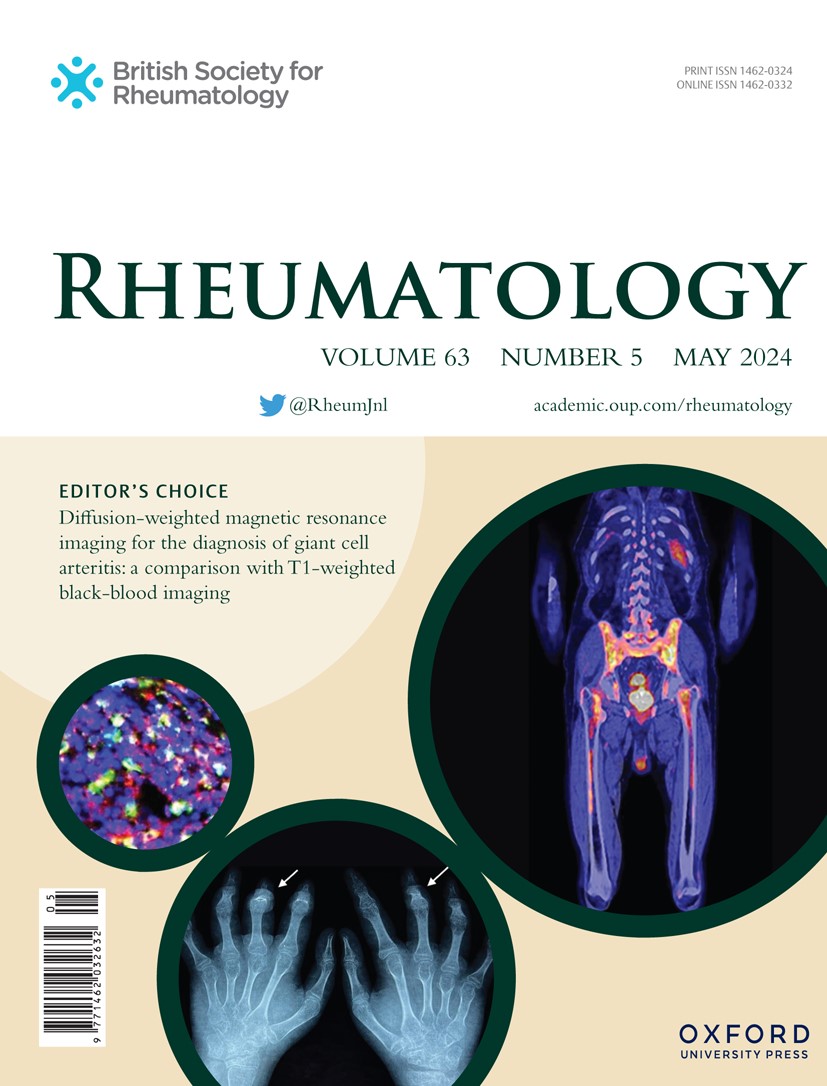抗疟药的使用与SLE患者LN风险降低相关吗?一项基于初始队列的研究结果。
IF 4.4
2区 医学
Q1 RHEUMATOLOGY
引用次数: 0
摘要
目的:抗疟药物是治疗SLE的基石,与多种有利的疾病结局相关。本研究探讨了抗疟药的使用是否与SLE患者发生LN的风险降低有关。方法:我们从没有LN病史的初始队列中纳入SLE患者,定期进行前瞻性随访。暴露(以年为单位的抗疟疾暴露累积持续时间)和结果(LN的发展,根据临床判断由狼疮活动引起的新发蛋白尿,并记录在SLEDAI-2K表中)之间的关系使用时间相关的单变量Cox比例风险模型来评估总体效果。合并临床相关变量,采用校正多变量Cox回归来估计LN的风险。结果本研究纳入674例首发SLE患者,中位基线年龄为33.6岁(四分位数间距[IQR]: 24.9-45.4)。154例(22.8%)患者出现sle相关的新发蛋白尿,提示发生LN,中位发病时间为3.6年[IQR: 0.9-8.8]。无论是在估计总体效果的未调整单变量模型中(风险比[HR]: 0.98; 95% CI: 0.94-1.02, P = 0.25),还是在调整多变量模型中(风险比:0.96;95% CI: 0.92-1.00, P = 0.08),抗疟药物暴露的累积持续时间与较低的LN风险均无显著相关。这一发现也在血清学活动性SLE患者的敏感性分析中得到证实(HR: 0.97; 95% CI: 0.92-1.02)。结论:抗疟药的使用与SLE患者LN发生风险的降低无显著相关。本文章由计算机程序翻译,如有差异,请以英文原文为准。
Is antimalarial use associated with a reduced risk of LN in patients with SLE? Results from an inception cohort-based study.
OBJECTIVES
Antimalarials are a cornerstone in managing SLE and are associated with multiple favourable disease outcomes. This study explored whether antimalarial use is associated with a reduced risk of incident LN in SLE patients.
METHODS
We included SLE patients from an inception cohort with no prior history of LN, followed prospectively at regular intervals. The relationship between the exposure (cumulative duration of antimalarial exposure in years) and the outcome (development of LN, as indicated by new-onset proteinuria attributed to lupus activity by clinical judgement and recorded in the SLEDAI-2K sheet) was characterized using a time-dependent univariable Cox proportional hazards model to estimate the overall effect. Adjusted multivariable Cox regression was also employed to estimate the risk of LN, incorporating clinically relevant variables.
RESULTS
The study included 674 inception SLE patients, with a median baseline age of 33.6 years (interquartile range [IQR]: 24.9-45.4). One hundred and fifty-four patients (22.8%) developed SLE-related new-onset proteinuria, indicating LN, with a median time to event of 3.6 years [IQR: 0.9-8.8]. Cumulative duration of antimalarial exposure was not significantly associated with a lower risk of LN, either in the unadjusted univariable model estimating the overall effect (hazard ratio [HR]: 0.98; 95% CI: 0.94-1.02, P = 0.25) or in the adjusted multivariable model (HR: 0.96; 95% CI: 0.92-1.00, P = 0.08). This finding was also corroborated in a sensitivity analysis of patients with serologically active SLE (HR: 0.97; 95% CI: 0.92-1.02).
CONCLUSION
Antimalarial use is not significantly associated with a reduced risk of incident LN in SLE patients.
求助全文
通过发布文献求助,成功后即可免费获取论文全文。
去求助
来源期刊

Rheumatology
医学-风湿病学
CiteScore
9.40
自引率
7.30%
发文量
1091
审稿时长
2 months
期刊介绍:
Rheumatology strives to support research and discovery by publishing the highest quality original scientific papers with a focus on basic, clinical and translational research. The journal’s subject areas cover a wide range of paediatric and adult rheumatological conditions from an international perspective. It is an official journal of the British Society for Rheumatology, published by Oxford University Press.
Rheumatology publishes original articles, reviews, editorials, guidelines, concise reports, meta-analyses, original case reports, clinical vignettes, letters and matters arising from published material. The journal takes pride in serving the global rheumatology community, with a focus on high societal impact in the form of podcasts, videos and extended social media presence, and utilizing metrics such as Altmetric. Keep up to date by following the journal on Twitter @RheumJnl.
 求助内容:
求助内容: 应助结果提醒方式:
应助结果提醒方式:


